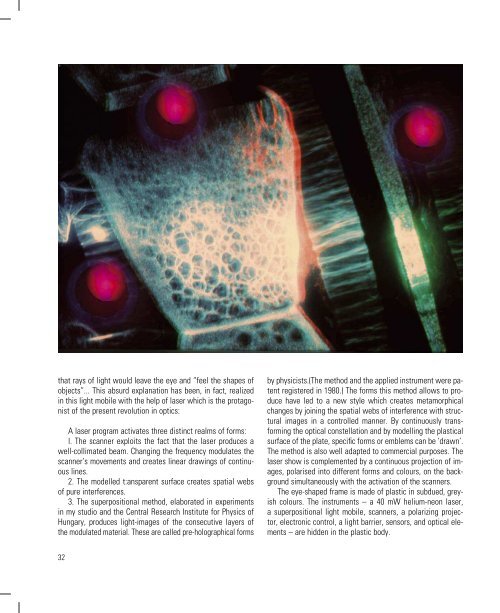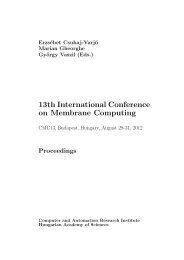Time on the Tilt
Time on the Tilt
Time on the Tilt
Create successful ePaper yourself
Turn your PDF publications into a flip-book with our unique Google optimized e-Paper software.
On <strong>the</strong> Expanding Borders of <strong>the</strong> Visible Universe:<br />
Holography in an Artist’s Approach<br />
Associating that which can be seen with that which exists is a<br />
centuries old misc<strong>on</strong>cepti<strong>on</strong>. The maxim “seeing is believing”<br />
can be heard quite often even today, though such a narrowing<br />
of reas<strong>on</strong> seem grotesquely humorous and refers more to <strong>the</strong><br />
pers<strong>on</strong> uttering it than to reality. Paradoxically such doubts may<br />
also carry a positive momentum – or at least some thought<br />
encouraging distrust – provided <strong>the</strong>y do not lead into rigid<br />
c<strong>on</strong>clusi<strong>on</strong>s but relate to <strong>the</strong> manifest need of creating a mental<br />
image of <strong>the</strong> world. We are living in a c<strong>on</strong>tinuous electromagnetic<br />
flux. The overwhelming majority of <strong>the</strong> electromagnetic<br />
radiati<strong>on</strong> is invisible to our direct percepti<strong>on</strong>. With <strong>the</strong><br />
aid of instruments however, man was able to expand <strong>the</strong> radius<br />
of percepti<strong>on</strong>. In <strong>the</strong> twentieth century <strong>the</strong> importance of<br />
instruments has become crucial. With regards to <strong>the</strong> expansi<strong>on</strong><br />
of visibility instruments seem to display parallelisms with<br />
<strong>the</strong> views of Paul Klee <strong>the</strong> excellent painter of <strong>the</strong> first part of<br />
<strong>the</strong> twentieth century: The artist’s task is not to mirror, but to<br />
make visible.<br />
that rays of light would leave <strong>the</strong> eye and “feel <strong>the</strong> shapes of<br />
objects”... This absurd explanati<strong>on</strong> has been, in fact, realized<br />
in this light mobile with <strong>the</strong> help of laser which is <strong>the</strong> protag<strong>on</strong>ist<br />
of <strong>the</strong> present revoluti<strong>on</strong> in optics:<br />
A laser program activates three distinct realms of forms:<br />
l. The scanner exploits <strong>the</strong> fact that <strong>the</strong> laser produces a<br />
well-collimated beam. Changing <strong>the</strong> frequency modulates <strong>the</strong><br />
scanner’s movements and creates linear drawings of c<strong>on</strong>tinuous<br />
lines.<br />
2. The modelled t:ansparent surface creates spatial webs<br />
of pure interferences.<br />
3. The superpositi<strong>on</strong>al method, elaborated in experiments<br />
in my studio and <strong>the</strong> Central Research Institute for Physics of<br />
Hun gary, produces light-images of <strong>the</strong> c<strong>on</strong>secutive layers of<br />
<strong>the</strong> modulated material. These are called pre-holographical forms<br />
by physicists.(The method and <strong>the</strong> applied instrument were patent<br />
registered in 1980.) The forms this method allows to produce<br />
have led to a new style which creates metamorphical<br />
changes by joining <strong>the</strong> spatial webs of interference with structural<br />
images in a c<strong>on</strong>trolled manner. By c<strong>on</strong>tinuously transforming<br />
<strong>the</strong> optical c<strong>on</strong>stellati<strong>on</strong> and by modelling <strong>the</strong> plastical<br />
surface of <strong>the</strong> plate, specific forms or emblems can be ‘drawn’.<br />
The method is also well adapted to commercial purposes. The<br />
laser show is complemented by a c<strong>on</strong>tinuous projecti<strong>on</strong> of images,<br />
polarised into different forms and colours, <strong>on</strong> <strong>the</strong> background<br />
simultaneously with <strong>the</strong> activati<strong>on</strong> of <strong>the</strong> scanners.<br />
The eye-shaped frame is made of plastic in subdued, greyish<br />
colours. The instruments – a 40 mW helium-ne<strong>on</strong> laser,<br />
a superpositi<strong>on</strong>al light mobile, scanners, a polarizing projector,<br />
electr<strong>on</strong>ic c<strong>on</strong>trol, a light barrier, sensors, and optical elements<br />
– are hidden in <strong>the</strong> plastic body.<br />
A transmissi<strong>on</strong> hologram dissolving across fields, Cambridge MEDIA LAB, 1988.<br />
32 33
















